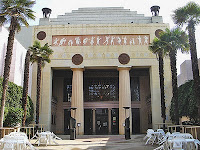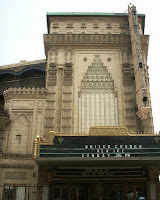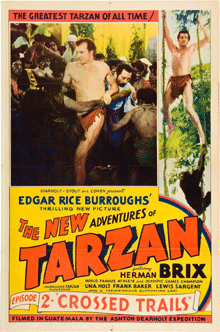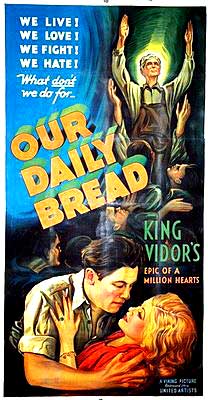It was in this architectural frame of mind that we found a neat little post by Marco Siegel-Acevedo over on his blog The Last Palace. A blogger who explores the different ways modern digital media and communication define the American landscape, Marco reminds us in a very personal way how integral place and setting are to the bijou experience. For some things, there are no substitutes.
Most of my quasi-religious experiences have happened in movie theaters, not churches. It’s no mystery, really. One sits in the dark, preferably a cavernous space, where one senses the presence of other souls, only you and they are focused on the visions before you, as intimate as dream, or memory. Or, in the case of the popular re-tellings of the Exodus story, as intimate as God speaking to you from out of a Burning Bush.
 Actually, the first time I heard God at the movies He was awesome and terrifying. It was the late 60s, and my father had taken me to see a holiday revival of De Mille’s The Ten Commandments at the Loews Paradise on the Grand Concourse in the Bronx, one of the five Loews Wonder Theaters in the New York area.
Actually, the first time I heard God at the movies He was awesome and terrifying. It was the late 60s, and my father had taken me to see a holiday revival of De Mille’s The Ten Commandments at the Loews Paradise on the Grand Concourse in the Bronx, one of the five Loews Wonder Theaters in the New York area.The decor of the place was impossibly lavish, even pagan. It was an “atmospheric” movie palace, meaning that the vast barrel-vault ceiling of the auditorium was designed to imitate the open sky, a deep blue which faded to night when the show started,
 |
| Majestic Theater, San Antonio TX (1928) (Click to enlarge) |
 |
| Staircase of the Loew's Wonder Theater at 175th Street(1930)(Click to enlarge) |
 |
| The Alex Theatre, Glendale CA(1925) (Click to enlarge) |
 |
| Loew's 175th Street Theater (Click to enlarge) |
 The second time I heard God at the movies, it was in the featureless black box of a modern multiplex. His voice was gentle and soothing. Once again he called to Moses from the Burning Bush, but this time He was a God of persuasion, not of command. De Mille's blinding atomic bush had become a gently iridescent shrub. "Moses," God whispered, almost inaudible in the desert breezes. And while I don't consider myself a religious person, per se, I wept. Because of the intimacy of scale, it was a powerful little scene in an otherwise run-of-the-mill animated musical (Dreamworks’ The Prince of Egypt): on the big screen, in that dark room, the message is aimed right at you, only at you.
The second time I heard God at the movies, it was in the featureless black box of a modern multiplex. His voice was gentle and soothing. Once again he called to Moses from the Burning Bush, but this time He was a God of persuasion, not of command. De Mille's blinding atomic bush had become a gently iridescent shrub. "Moses," God whispered, almost inaudible in the desert breezes. And while I don't consider myself a religious person, per se, I wept. Because of the intimacy of scale, it was a powerful little scene in an otherwise run-of-the-mill animated musical (Dreamworks’ The Prince of Egypt): on the big screen, in that dark room, the message is aimed right at you, only at you.POSTSCRIPT
While researching this post, I found a clip of the scene on YouTube... only to find no trace of the original power. The flame, it seems, burns brightest in the temple.
Thanks to Strange Culture for hosting the Film + Faith Blogathon, November 7-9, 2007.
A special thanks to Marco, for sharing his memories and allowing this reprint.
While each passing year marks the demise of some of America’s movie palace treasures, it also marks some amazing preservation success stories made possible by lovers of film, history, and architecture. Patrick Crowley and Ross Melnick have created a rich catalog of what’s been saved and what’s been lost over at their site, Cinema Treasures. A must see!
We at the Bijou salute these gentlemen and the efforts of all those who endeavor to keep the flame burning and the popcorn popping.











2 comments:
Thanks for the picture of the Majestic Theater in San Antonio. I was in the army stationed at Fort Sam Houston in San Antonio from January 1959 to August 1960. I used to go to the Majestic at least once a week.
When I returned to Philadelphia, the local movie palaces were starting to decay. The downtown Mastbaum Theater has since been razed and my local theater, the Logan, still stands. It had been a church. It looks like it is falling down
Hi! Nice blog you have here, congratulations!
I have used one of you pictures in my last post, the one which shows the face of Moses, in the movie "Prince of Egypt", and of course I have included a reference pointing to here. Hope you are agree, on the contrary, please tell me and I'll delete it.
See you.
Post a Comment